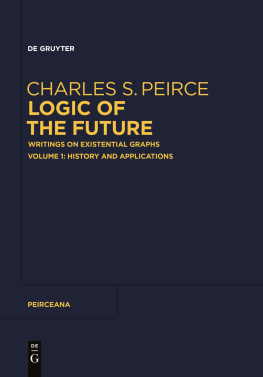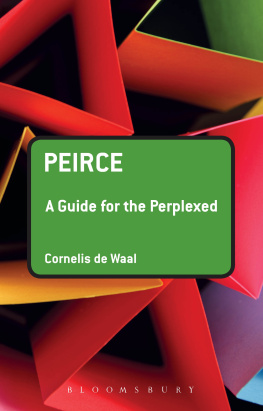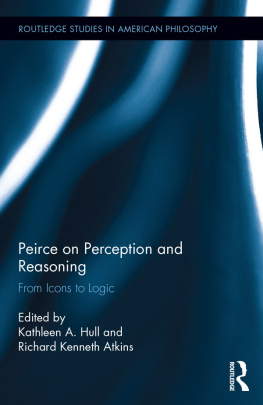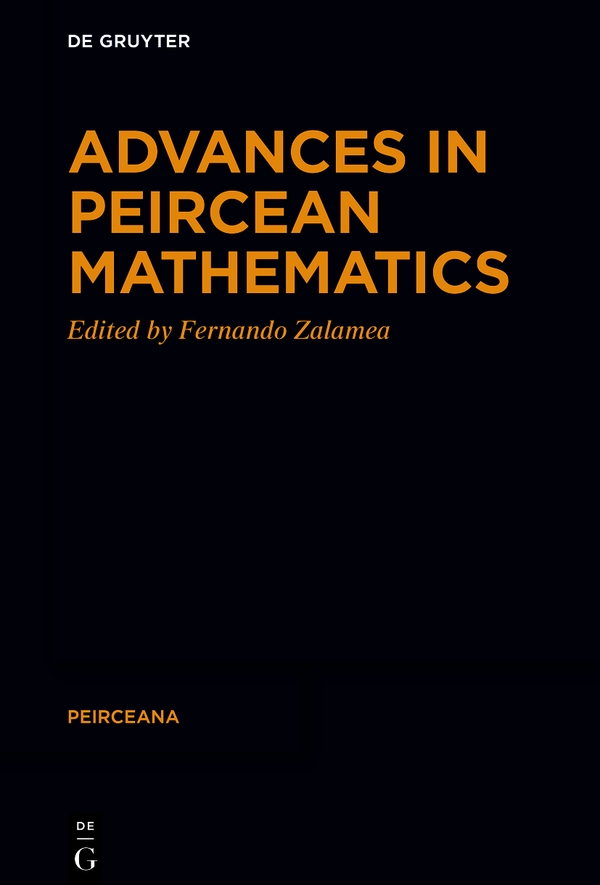Peirceana
Edited by
Francesco Bellucci
Ahti-Veikko Pietarinen
Volume
ISBN 9783110717617
e-ISBN (PDF) 9783110717631
e-ISBN (EPUB) 9783110717716
Bibliographic information published by the Deutsche Nationalbibliothek
The Deutsche Nationalbibliothek lists this publication in the Deutsche Nationalbibliografie; detailed bibliographic data are available on the Internet at http://dnb.dnb.de.
2023 Walter de Gruyter GmbH, Berlin/Boston
Advances in Peircean Mathematics
Peirceana

Edited by
Francesco Bellucci and Ahti-Veikko Pietarinen
Volume 7
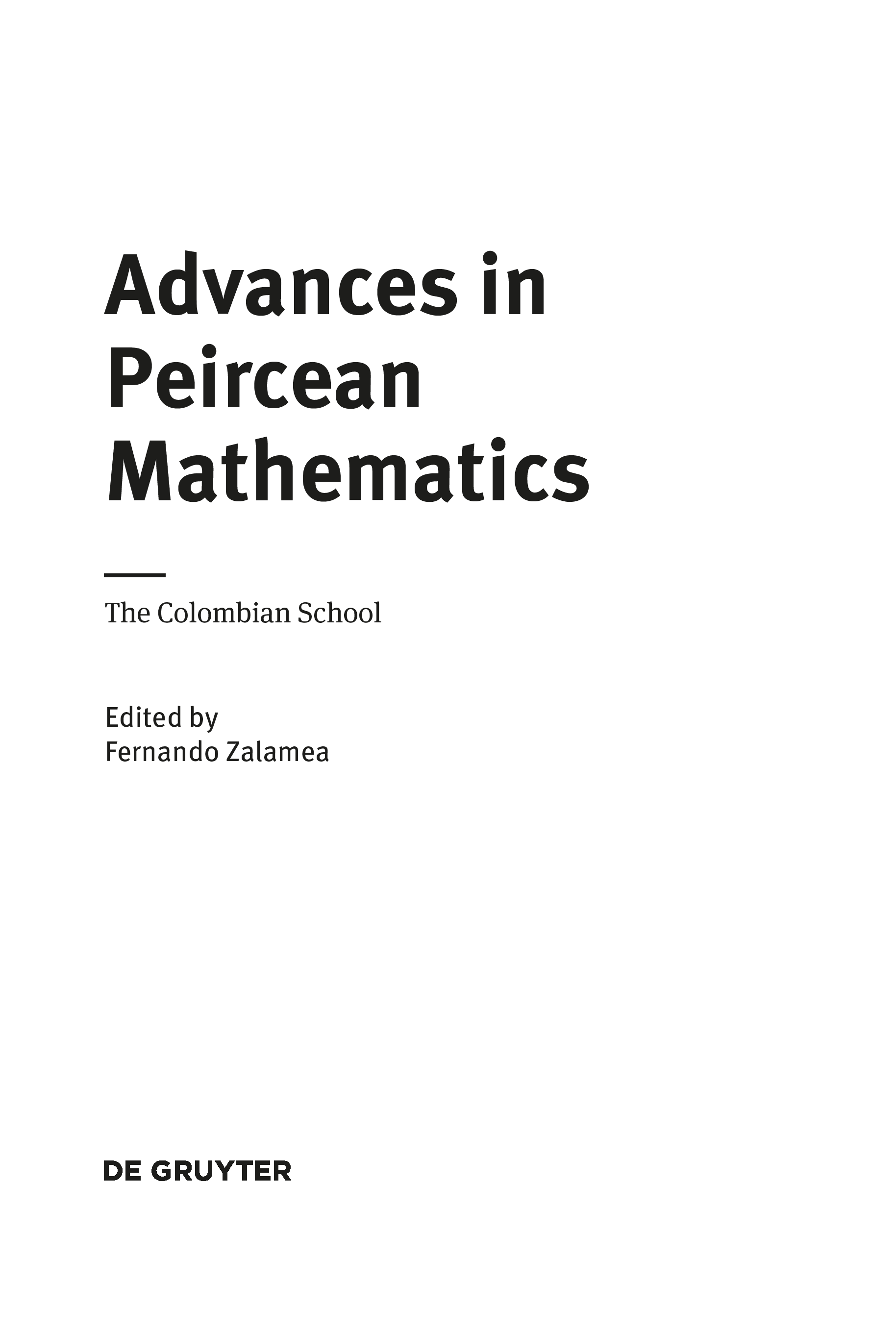
ISBN 978-3-11-071761-7
e-ISBN (PDF) 978-3-11-071763-1
e-ISBN (EPUB) 978-3-11-071771-6
ISSN 2698-7155
Library of Congress Control Number: 2022945932
Bibliographic information published by the Deutsche Nationalbibliothek
The Deutsche Nationalbibliothek lists this publication in the Deutsche Nationalbibliografie; detailed bibliographic data are available on the Internet at http://dnb.dnb.de.
2023 Walter de Gruyter GmbH, Berlin/Boston
Typesetting: Jukka Nikulainen
Printing and binding: CPI books GmbH, Leck
www.degruyter.com

May some future student go over this ground again, and have the leisure to give his results to the world.
Charles Sanders Peirce (1891) Collected Papers 6.34.
Dedication
We dedicate this volume to the loving memory of our friends and colleagues Yuri Poveda (19682021), who first offered a finite linear axiomatization of Peirces existential graphs, and William James McCurdy (19472021), a brilliant scholar in the Mathematics of Peirce, who was accomplishing a profound foundational program in the combinatorial topology of Peirces logic of relations.
Acknowledgments
Evolving slowly over the last 20 years, this volume has benefited from many hands. In particular, the visits to Bogot of dear friends and Peirce scholars helped much to foster the investigations included in this volume. Thanks are due to our visitors (some of them frequent) Shigeyuki Atarashi, Jeff Downard, Nicholas Guardiano, Jrme Havenel, Catherine Legg, Giovanni Maddalena, Rosa Mayorga, William James McCurdy, Matthew Moore, Jaime Nubiola, Ahti-Veikko Pietarinen, John Sowa. On another hand the Charles S. Peirce International Centennial Congress (Lowell, 2014) set a high standard that we tried to follow in this volume.
Special thanks are due to Gustavo Arengas for solving difficult TEX impasses, to Francisco Vargas for many improvements in the general and particular outlook of the volume, and to Arnold Oostra for his continuing support and strong immersion in the edition of all chapters. The three of them, Arnold, Francisco, Gustavo, produced extremely precise revisions, beyond all duties, of the entire book. Two readers for De Gruyter offered amazingly careful suggestions and comments, which enhanced and helped to correct the final product: many thanks to them. Finally, many thanks also to Jukka Nikulainen for the extraordinary typesetting of the final manuscript, and to Mara Weber for the overall edition of the volume.
Introduction
Fernando Zalamea
The Colombian School
In Latin America, and more generally in the Hispanic World, pragmatism came to our countries mainly through William James and John Dewey (particularly, through his influence in education). Studies in Spanish on Peirce were scarce and superficial until the end of the 20th century. The situation in Colombia follows that pattern. The slow development of a Colombian School on Peirce began with Fernando Zalameas Peircean Seminars (19961999) given at the Universidad Nacional de Colombia, where an important number of young scholars gathered. Zalamea centered his research on existential graphs and the continuum (19972001), converging in the first international monograph (2012) devoted to the mathematical entanglements of both the continuum and the graphs.
Meanwhile, Zalameas influence spread out (11 Thesis on Peirce), and students and colleagues began their own path, with the appearances of Eugenio Andrade (19992000) in biological thought, Douglas Nio (2000) in semiotics, and Arnold Oostra (20012004) in logic. Zalamea donated his Peircean books and microfilms to the Universidad Nacional, in order to create the Acervo Peirceano (1999), possibly the largest collection of specialized material on Peirce in Latin America.
The main Colombian Peirce scholars continued their work in the 20002010 decade along diverse paths. Zalamea (20002006) profited from continuity and triadicity to propose novel perspectives on Latin American cultural studies. Nio (2008) wrote an extended chronological and critical Ph.D. Thesis on the development of abduction, without doubt the deepest study available on the theme at an international level. Andrade (20072009) advanced in his construction of a theory of biosemiotics based on Peirces categories. And, above all, Oostra founded in 2007 his Seminario Permanente Peirce at the Universidad del Tolima (22 Thesis on Peirce), where his school on Peirces mathematical logic has flourished (binary connectives, triadic logic, diagrams, intuitionism, existential graphs), to become the leading World center specialized in Peirces graphs.
Time was ripe to organize the community and Zalamea created the Centro de Sistemtica Peirceana (CSP) in 2007. The CSP has oriented its main task to the production of a yearly journal devoted to Peirce, the Cuadernos de Sistemtica Peirceana. The first five numbers of the journal were written in Spanish by the local Colombian community of the CSP: Eugenio Andrade (biology), Gonzalo Baquero (philosophy), Carlos Garzn (philosophy), Lorena Ham (linguistics), Richard Kalil (philosophy), Jaime Lozano (economy), Alejandro Martn (mathematics), Douglas Nio (semiotics), Arnold Oostra (mathematics), Roberto Perry (phonetics), Laura Pinilla (medicine), Miguel ngel Riao (philosophy), Edison Torres (philosophy), Fernando Zalamea (mathematics). One can consider a small feat the organization of such a multiverse community and its capacity to maintain a journal devoted specifically to Peirce (a unique fact, since even the Transactions extends itself towards general American philosophy). In contraposition with the initial local perspective, the next three numbers of the Cuadernos were oriented to articles by the global community (many languages represented, not just English) around monographic numbers: Esthetics (2014), Mathematics (2015), Existential Graphs (2016). Peirce would certainly have been intrigued to see a devoted community working on his heritage in a remote country that he never would have dreamed of.
This Volume
This volume concentrates on the Mathematics of Peirce, technically studied by the Colombian School. The three main topics concerned are the mathematizations and proofs of Peirces Pragmaticist Maxim (Gustavo Arengas, Chapter 1), the construction and development of a full model for Peirces



